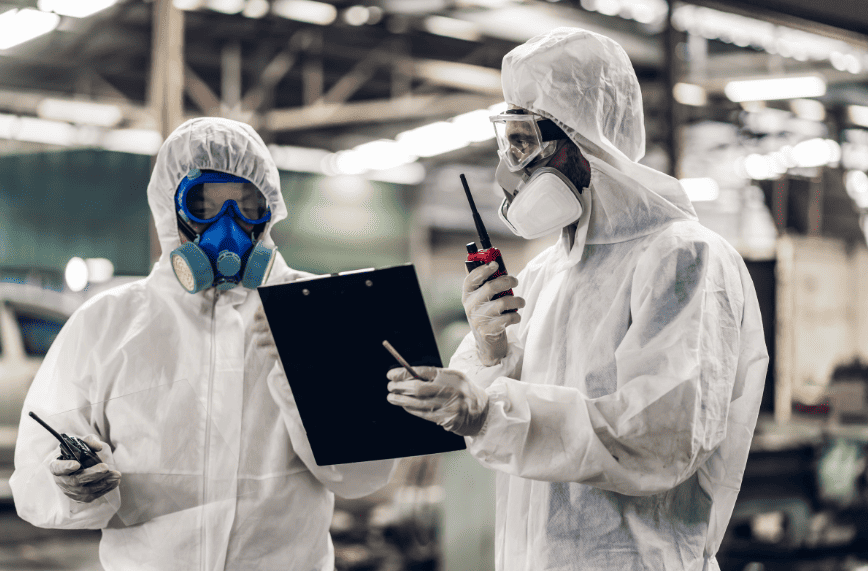In the modern industrial age, chemicals have become an integral part of our workspaces, driving innovation and enhancing productivity. Yet, their potential risks to both humans and the environment cannot be understated and it is crucial to protect the workplace from chemical hazards.
Table of Contents
This article delves deep into the multifaceted world of chemical safety – from understanding the importance of clear hazard communication and decoding the realm of Safety Data Sheets (SDS) to gearing up with the right protective equipment and navigating complex regulations.
On this post, we’ll walk you through the essential strategies to protect the workplace from chemical hazards. Let’s embark on this journey to creating safer, more informed workplaces.
Protect the Workplace from Chemical Hazards: Getting the Word Out
Working with chemicals is no child’s play. Even with all the benefits they bring, if mishandled, they can turn things upside down in a jiffy. This is where hazard communication steps in – it’s like giving everyone the manual on dealing with these potential troublemakers.

Decoding Safety Data Sheets
Ever wished for a cheat sheet that tells you everything about a chemical? Enter Safety Data Sheets (SDS). These documents are like the Wikipedia page for any hazardous chemical. They tell you what’s in it, how it behaves, the problems it might cause, and how to stay in its good books.
And the best part? By law, employers have to hand them out for every hazardous chemical in the workplace. Plus, they’ve got to train the team on how to read them, almost like a book club, but for safety.
Using the SDS, workers get to peer into the essence of the chemicals, understand their mood swings, and learn how not to rub them the wrong way.
Deciphering Chemical Labels
One way to protect the workplace from chemical hazards is as simple as using labels. Imagine if chemicals came with a simple tag, something like: “Hey, I’m super flammable! Don’t keep me near that open flame.” That’s precisely the idea behind the labeling system.
These labels are like a mini biography, giving workers a snapshot of a chemical’s personality – its name, what ticks it off, and how to dance with it without stepping on its toes.
Employers play the role of the strict librarian here, ensuring every chemical has its label intact. Meanwhile, workers need to become fluent in this labeling language, knowing how to decode these tags for safe handling.
Guarding Against Chemical Threats: Proactive Steps for Safety
The Balancing Act of Prevention
Navigating a workplace bustling with chemicals is a bit like tightrope walking: one wrong step could spell disaster. But with the right preventive measures, it becomes less of a perilous act and more of a well-choreographed dance. Employers lay the stage, and employees perfect the performance.
Suiting Up: The Armor of Personal Protective Equipment (PPE)
Imagine PPE as the ultimate defense armor in the chemical realm. It’s gloves that shield hands from harmful agents, respirators that filter out dangerous particles, hazmat suits that envelope the whole body against contaminants, and goggles that protect the eyes from sudden splashes.
Possessing this gear isn’t the end game—using them correctly is. With companies such as Mira Safety producing high quality PPE, providing safety equipment isn’t a difficult task.
Employers stand front and center, providing this essential armor and ensuring each piece is top-notch. On the flip side, employees must embrace each item like their own protective layer—knowing when to gear up, how to maintain them, and recognizing when to replace any worn-out component.
Emergency Response
In the event of a chemical hazard emergency, it is critical to have a well-planned emergency response plan in place. This plan should include procedures for first aid and evacuation.
First Aid Procedures
Employees who may come into contact with hazardous chemicals should receive training on first aid procedures specific to the chemicals they work with. The following are general first aid procedures that should be followed in the event of a chemical exposure:
- Remove contaminated clothing and rinse the affected area with water for at least 15 minutes.
- Seek medical attention immediately.
- If the chemical is inhaled, move to an area with fresh air.
- If the chemical is ingested, do not induce vomiting.
Evacuation Plan
An evacuation plan should be established and communicated to all employees. The following steps should be included in the plan:
- Sound the alarm and notify emergency services.
- Evacuate the building using designated exit routes.
- Move to a safe distance from the building.
- Account for all employees and visitors.
- Do not re-enter the building until emergency services have declared it safe to do so.
Regular drills should be conducted to ensure that all employees are familiar with the emergency response plan and procedures.

Staying Safe: Navigating Chemical Regulations
Working with chemicals requires a meticulous approach, much like skillfully handling power tools. This is where the guidelines set by authorities such as OSHA come into play, providing a safety net that helps workplaces maintain both safety and efficiency.
HCS by OSHA
A blueprint for chemical safety, demanding clear communication via safety data sheets (SDS) and labels.
CFATS
Issued by the Department of Homeland Security, these rules ensure facilities with specific chemicals are safeguarded against threats.
EPA’s Guidelines
Dictate the correct storage, treatment, and disposal of hazardous waste, prioritizing environmental safety.
Staying Updated
For businesses, compliance is continuous. Regular training and staying updated on regulatory changes are paramount.
Ensuring a Safe Chemical Future: The Road Ahead
The world of chemical safety is expansive and continually evolving, demanding both employers and employees to be ever-vigilant. The key lies in comprehensive education, stringent preventive measures, and an unwavering commitment to adhering to safety standards and regulations.
As we harness the power of chemicals to fuel our industries and innovations, let’s also ensure that our workspaces remain safe havens for everyone. Because in the end, safety isn’t just about following rules—it’s about preserving and cherishing human lives and our environment.



